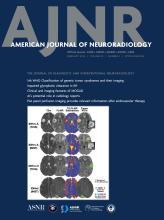Index by author
Telesca, Donatello
- EDITOR'S CHOICEBrain Tumor ImagingYou have accessQuantification of T2-FLAIR Mismatch in Nonenhancing Diffuse Gliomas Using Digital SubtractionNicholas S. Cho, Francesco Sanvito, Viên Lam Le, Sonoko Oshima, Ashley Teraishi, Jingwen Yao, Donatello Telesca, Catalina Raymond, Whitney B. Pope, Phioanh L. Nghiemphu, Albert Lai, Timothy F. Cloughesy, Noriko Salamon and Benjamin M. EllingsonAmerican Journal of Neuroradiology February 2024, 45 (2) 188-197; DOI: https://doi.org/10.3174/ajnr.A8094
The T2-FLAIR mismatch sign on MR imaging, usually determined by visual assessment, is a highly specific imaging biomarker of IDH-mutant astrocytomas. The authors of this study quantified the degree of T2-FLAIR mismatch in nonenhancing diffuse gliomas. Thresholds of ≥42% T2-FLAIR mismatch volume classified IDH-mutant astrocytoma with a specificity/sensitivity of 100%/19.6% (TCIA) and 100%/31.6% (institutional). They also found that grades 3–4 compared with grade 2 IDH-mutant astrocytomas (P<.05) had a higher percentage T2-FLAIR mismatch volume.
Teraishi, Ashley
- EDITOR'S CHOICEBrain Tumor ImagingYou have accessQuantification of T2-FLAIR Mismatch in Nonenhancing Diffuse Gliomas Using Digital SubtractionNicholas S. Cho, Francesco Sanvito, Viên Lam Le, Sonoko Oshima, Ashley Teraishi, Jingwen Yao, Donatello Telesca, Catalina Raymond, Whitney B. Pope, Phioanh L. Nghiemphu, Albert Lai, Timothy F. Cloughesy, Noriko Salamon and Benjamin M. EllingsonAmerican Journal of Neuroradiology February 2024, 45 (2) 188-197; DOI: https://doi.org/10.3174/ajnr.A8094
The T2-FLAIR mismatch sign on MR imaging, usually determined by visual assessment, is a highly specific imaging biomarker of IDH-mutant astrocytomas. The authors of this study quantified the degree of T2-FLAIR mismatch in nonenhancing diffuse gliomas. Thresholds of ≥42% T2-FLAIR mismatch volume classified IDH-mutant astrocytoma with a specificity/sensitivity of 100%/19.6% (TCIA) and 100%/31.6% (institutional). They also found that grades 3–4 compared with grade 2 IDH-mutant astrocytomas (P<.05) had a higher percentage T2-FLAIR mismatch volume.
Torres, Carlos
- EditorialYou have accessStriking a Balance: Global Perspectives on Neuroradiology Workload and Quality of ServiceMax Wintermark, Kei Yamada, Tchoyoson Lim, Roy Riascos, Carlos Torres and Tarek YousryAmerican Journal of Neuroradiology February 2024, 45 (2) 127; DOI: https://doi.org/10.3174/ajnr.A8125
Vachha, B.
- Neuroimaging Physics/Functional Neuroimaging/CT and MRI TechnologyYou have accessRecommended Resting-State fMRI Acquisition and Preprocessing Steps for Preoperative Mapping of Language and Motor and Visual Areas in Adult and Pediatric Patients with Brain Tumors and EpilepsyV.A. Kumar, J. Lee, H.-L. Liu, J.W. Allen, C.G. Filippi, A.I. Holodny, K. Hsu, R. Jain, M.P. McAndrews, K.K. Peck, G. Shah, J.S. Shimony, S. Singh, M. Zeineh, J. Tanabe, B. Vachha, A. Vossough, K. Welker, C. Whitlow, M. Wintermark, G. Zaharchuk and H.I. SairAmerican Journal of Neuroradiology February 2024, 45 (2) 139-148; DOI: https://doi.org/10.3174/ajnr.A8067
Validrighi, Alexandria
- FELLOWS' JOURNAL CLUBPediatric NeuroimagingYou have accessClinical and Imaging Findings in Children with Myelin Oligodendrocyte Glycoprotein Antibody Associated Disease (MOGAD): From Presentation to RelapseElizabeth George, Jeffrey B. Russ, Alexandria Validrighi, Heather Early, Mark D. Mamlouk, Orit A. Glenn, Carla M. Francisco, Emmanuelle Waubant, Camilla Lindan and Yi LiAmerican Journal of Neuroradiology February 2024, 45 (2) 229-235; DOI: https://doi.org/10.3174/ajnr.A8089
This study characterizes the CNS imaging manifestations of pediatric MOGAD. The authors also identify the clinical and imaging variables associated with relapse. There is an age-dependent imaging phenotype at presentation and first relapse, and older age at presentation is associated with shorter time to relapse.
Van Den Berg, René
- NeurointerventionYou have accessTransarterial Embolization of Anterior Cranial Fossa Dural AVFs as a First-Line Approach: A Single-Center StudyCarl A. J. Puylaert, René van den Berg, Bert A. Coert and Bart J. EmmerAmerican Journal of Neuroradiology February 2024, 45 (2) 171-175; DOI: https://doi.org/10.3174/ajnr.A8092
Vibhute, Prasanna
- FELLOWS' JOURNAL CLUBBrain Tumor ImagingOpen AccessNewly Recognized Genetic Tumor Syndromes of the CNS in the 5th WHO Classification: Imaging Overview with Genetic UpdatesAmit Agarwal, Girish Bathla, Neetu Soni, Amit Desai, Pranav Ajmera, Dinesh Rao, Vivek Gupta and Prasanna VibhuteAmerican Journal of Neuroradiology February 2024, 45 (2) 128-138; DOI: https://doi.org/10.3174/ajnr.A8039
In this review of the new 5th edition of the WHO classification, the authors focus on imaging and genetic characteristics of 8 new syndromes: Elongator protein complex-medulloblastoma syndrome, BRCA1-associated protein 1 tumor-predisposition syndrome, DICER1 syndrome, familial paraganglioma syndrome, melanoma-astrocytoma syndrome, Carney complex, Fanconi anemia, and familial retinoblastoma.
Vidal, Lorenna
- Pediatric NeuroimagingYou have accessMRI-Based Brain Volume Scoring in Cerebral Malaria Is Externally Valid and Applicable to Lower-Resolution ImagesManu S. Goyal, Lorenna Vidal, Karen Chetcuti, Cowles Chilingulo, Khalid Ibrahim, Jeffrey Zhang, Dylan S. Small, Karl B. Seydel, Nicole O’Brien, Terrie E. Taylor and Douglas G. PostelsAmerican Journal of Neuroradiology February 2024, 45 (2) 205-210; DOI: https://doi.org/10.3174/ajnr.A8098
Vossough, A.
- Neuroimaging Physics/Functional Neuroimaging/CT and MRI TechnologyYou have accessRecommended Resting-State fMRI Acquisition and Preprocessing Steps for Preoperative Mapping of Language and Motor and Visual Areas in Adult and Pediatric Patients with Brain Tumors and EpilepsyV.A. Kumar, J. Lee, H.-L. Liu, J.W. Allen, C.G. Filippi, A.I. Holodny, K. Hsu, R. Jain, M.P. McAndrews, K.K. Peck, G. Shah, J.S. Shimony, S. Singh, M. Zeineh, J. Tanabe, B. Vachha, A. Vossough, K. Welker, C. Whitlow, M. Wintermark, G. Zaharchuk and H.I. SairAmerican Journal of Neuroradiology February 2024, 45 (2) 139-148; DOI: https://doi.org/10.3174/ajnr.A8067
Waubant, Emmanuelle
- FELLOWS' JOURNAL CLUBPediatric NeuroimagingYou have accessClinical and Imaging Findings in Children with Myelin Oligodendrocyte Glycoprotein Antibody Associated Disease (MOGAD): From Presentation to RelapseElizabeth George, Jeffrey B. Russ, Alexandria Validrighi, Heather Early, Mark D. Mamlouk, Orit A. Glenn, Carla M. Francisco, Emmanuelle Waubant, Camilla Lindan and Yi LiAmerican Journal of Neuroradiology February 2024, 45 (2) 229-235; DOI: https://doi.org/10.3174/ajnr.A8089
This study characterizes the CNS imaging manifestations of pediatric MOGAD. The authors also identify the clinical and imaging variables associated with relapse. There is an age-dependent imaging phenotype at presentation and first relapse, and older age at presentation is associated with shorter time to relapse.








